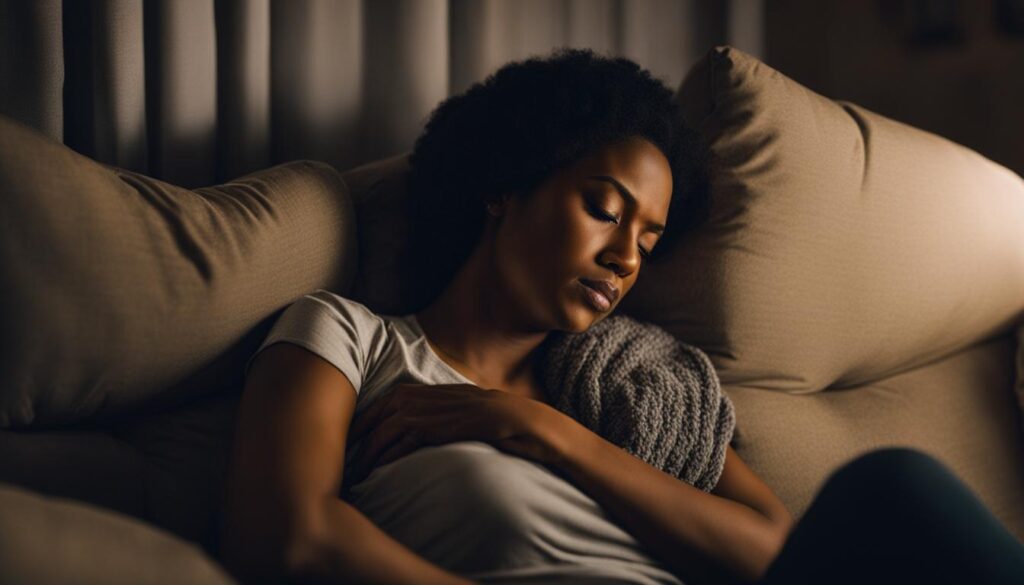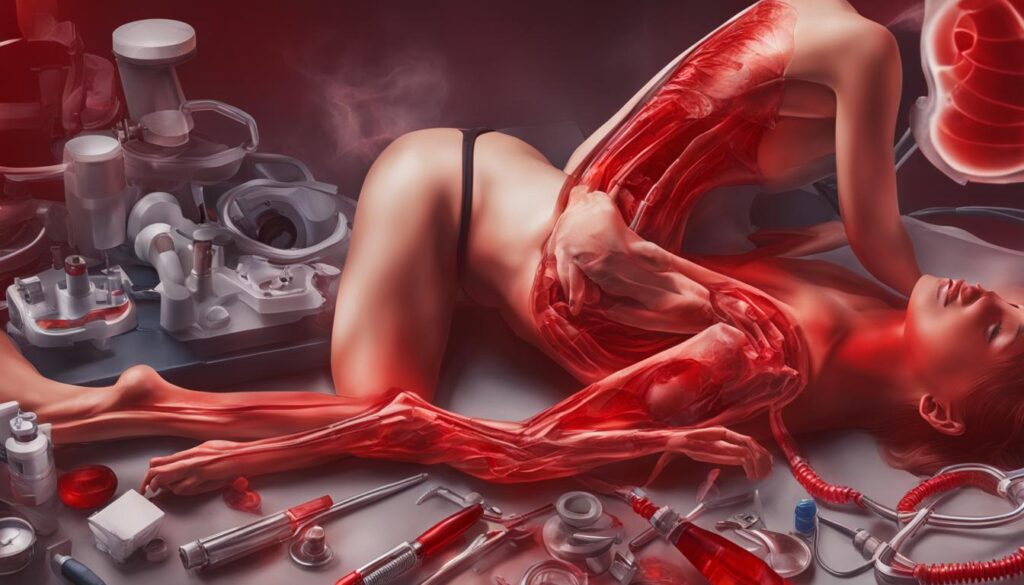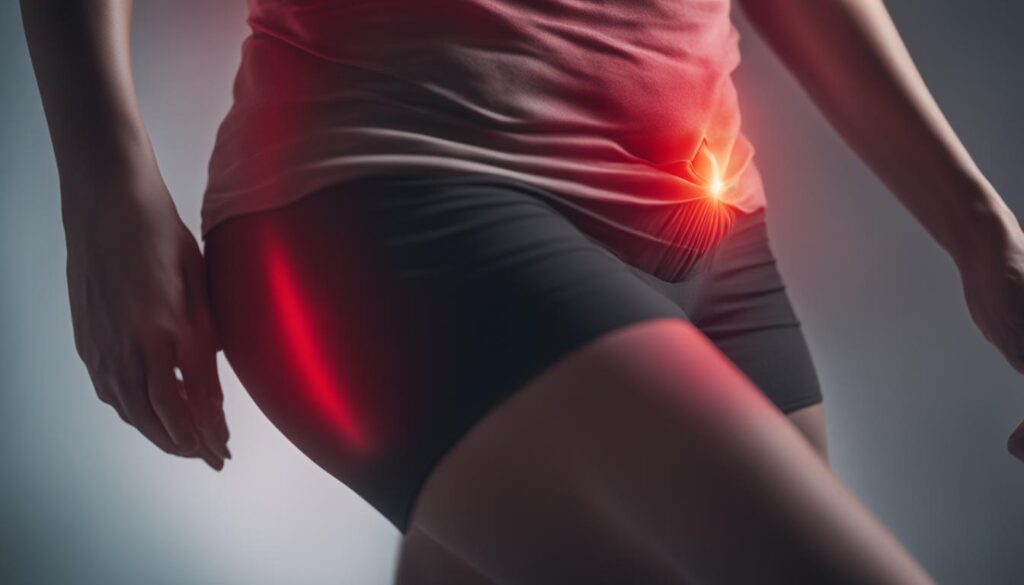Many women experience cramps even when they are not on their period. It can be perplexing to have period-like cramps outside of your menstrual cycle. Understanding the causes, symptoms, and remedies for these puzzling pains is crucial for finding relief.
There are several possible reasons why you may experience sudden onset cramps when you’re not on your period. It could be due to ovulation, where the ovaries release an egg, or it could be caused by conditions such as inflammatory bowel diseases, ruptured ovarian cysts, pregnancy, endometriosis, pelvic inflammatory disease, and more. It is important to consult a healthcare professional for a proper diagnosis and treatment options.
If you’re experiencing intermittent cramps outside of your menstrual cycle, it’s important not to ignore them. Unexplained abdominal pain, pelvic pain between periods, and menstrual irregularities with cramping should be evaluated by a medical professional to rule out any underlying health issues.
By understanding the causes and seeking appropriate medical care, you can manage these symptoms and find relief. Remember, you are not alone in experiencing period cramps when not on your period, and there are solutions available to help you feel better.
Key Takeaways:
- Period cramps when not on your period can have various causes, such as ovulation, inflammatory bowel diseases, ruptured ovarian cysts, pregnancy, endometriosis, and pelvic inflammatory disease.
- It is important to consult a doctor for a proper diagnosis and treatment options if you experience cramps when you’re not on your period.
- Managing symptoms and finding relief is possible with the guidance of healthcare professionals.
- Don’t ignore persistent or severe cramps outside of your menstrual cycle, as they could indicate an underlying health issue.
- Remember that you are not alone in experiencing period cramps when not on your period, and there are solutions available to help you feel better.
Inflammatory Bowel Diseases (IBD)
Inflammatory bowel diseases (IBD) are chronic conditions that cause inflammation and irritation in the digestive tract. The two main types of IBD are Crohn’s disease and ulcerative colitis. These conditions can lead to various symptoms, including cramps.
Crohn’s disease: This form of IBD causes cramps and pain in the right lower or middle parts of the belly. The severity of the cramps can vary, ranging from mild discomfort to intense pain. Other symptoms may include diarrhea, loss of appetite, fatigue, and fever.
Ulcerative colitis: For individuals with ulcerative colitis, cramps typically occur on the lower left side of the stomach. These cramps can be accompanied by abdominal pain and discomfort. Other symptoms of ulcerative colitis include frequent diarrhea, bloody stools, fatigue, and weight loss.
| IBD Symptom | Crohn’s Disease | Ulcerative Colitis |
|---|---|---|
| Cramps | Right lower or middle belly | Lower left side of the stomach |
| Diarrhea | Common | Frequent |
| Loss of Appetite | Yes | Yes |
| Fatigue | Yes | Yes |
| Fever | Possible | Uncommon |
If you are experiencing persistent cramps or other symptoms associated with IBD, it is important to consult with a healthcare professional for a proper diagnosis and appropriate treatment plan. They can help manage your symptoms and provide guidance to improve your quality of life.
“Living with IBD can be challenging, but with the right support and treatment, it is possible to manage the symptoms and lead a fulfilling life.” – Dr. Smith, Gastroenterologist
Ovulation: Understanding Mittelschmerz and Ovulation Cramps
Ovulation is a natural process that occurs in the menstrual cycle, where the ovaries release an egg for possible fertilization. It typically takes place around 10-14 days before your period starts. During ovulation, some women experience cramps known as mittelschmerz. These cramps are usually felt on one side of the lower belly and can range from sharp to dull.
Mittelschmerz, or ovulation cramps, is considered a normal part of the menstrual cycle for many women. It is often a sign that a mature egg has been released and is ready for fertilization. However, not all women experience ovulation cramps, and the intensity and frequency of the cramps can vary from person to person.
While ovulation cramps are generally harmless, they can sometimes be mistaken for other types of abdominal pain. It’s essential to understand the timing and characteristics of your cramps to differentiate them from other potential causes. If you experience severe or ongoing pain, it’s advisable to consult a healthcare professional for proper evaluation and guidance.
Ruptured Ovarian Cyst
One possible cause of cramps when not on your period is a ruptured ovarian cyst. Ovarian cysts are fluid-filled sacs that can form on the ovaries. When a cyst ruptures, it can cause sudden, sharp cramps on either side of the lower stomach. In addition to cramping, you may also experience spotting, pain or pressure in the lower belly, thighs, or lower back.
If you suspect you may have a ruptured ovarian cyst, it is important to seek medical attention for a proper diagnosis and treatment. Your doctor may perform a physical examination, order imaging tests such as an ultrasound, and recommend pain management strategies. Treatment options for a ruptured ovarian cyst may include pain medication, rest, and in some cases, surgical intervention.
Table: Symptoms of a Ruptured Ovarian Cyst
| Symptom | Description |
|---|---|
| Sharp abdominal pain | Severe, sudden cramping on one or both sides of the lower belly |
| Spotting or vaginal bleeding | Light bleeding or spotting may occur due to the rupture |
| Pain or pressure in the lower belly, thighs, or lower back | Discomfort may radiate to other areas of the body |
If you experience symptoms of a ruptured ovarian cyst or have any concerns about your reproductive health, it is important to consult with a healthcare professional. They can provide an accurate diagnosis and recommend appropriate treatment options to help alleviate your symptoms and prevent any potential complications.
Pregnancy Pain
Pregnancy can bring about various physical discomforts, including mild cramps that resemble period pain. These cramps, known as implantation pains, typically occur around four weeks into pregnancy when the embryo attaches to the uterine lining. While the sensation can be similar to menstrual cramps, it is important to note that every woman’s experience of pregnancy pain may vary.
Alongside implantation pain, other early pregnancy symptoms may manifest. These can include nausea, commonly known as morning sickness, sore or tender breasts, and frequent urination. It is essential to consult with a healthcare provider to confirm pregnancy and address any concerns related to pain or other symptoms experienced during the early stages of pregnancy.
“Pregnancy pain, including implantation cramps, can be a normal part of the early stages of pregnancy. However, it is always important to consult with a healthcare professional for proper evaluation and guidance.”
Understanding and managing pregnancy pain is crucial for the well-being of both the mother and the developing baby. By staying informed and seeking appropriate medical care, expectant mothers can ensure a healthy and comfortable pregnancy journey.

Ectopic Pregnancy
Ectopic pregnancy is a serious medical condition in which a fertilized egg implants outside of the uterus. It is essential to recognize the symptoms of ectopic pregnancy because prompt diagnosis and treatment are crucial for preventing life-threatening complications.
Ectopic pregnancy symptoms often include mild cramps followed by sudden, sharp, stabbing pains on one side of the lower belly. These abdominal pains may be accompanied by vaginal bleeding or spotting. While some women may experience typical pregnancy signs such as nausea and sore breasts, not all women with an ectopic pregnancy will have these symptoms.
If you suspect you may have an ectopic pregnancy, it is important to seek immediate medical attention. In most cases, an ectopic pregnancy cannot proceed to a healthy full-term pregnancy and requires medical intervention. Treatment options for ectopic pregnancy may include medication to dissolve the pregnancy or surgery to remove the embryo.
| Key Symptoms of Ectopic Pregnancy | Medical Action |
|---|---|
| Mild cramps followed by sudden, sharp, stabbing pains on one side of the lower belly | Seek immediate medical attention |
| Vaginal bleeding or spotting | |
| Nausea and sore breasts (not always present) |
Remember, ectopic pregnancy is a serious medical condition that requires urgent medical attention. If you suspect you may be experiencing an ectopic pregnancy, do not hesitate to consult with a healthcare professional.
Miscarriage
A miscarriage refers to the loss of a pregnancy before the 20th week. It can be a devastating experience for women and their partners. Miscarriages are more common than most people realize, with about 10-20% of known pregnancies ending in miscarriage. Understanding the symptoms of a miscarriage is important for early detection and seeking medical attention.
The most common symptom of a miscarriage is vaginal bleeding, which may be accompanied by abdominal cramping. The bleeding can range from light spotting to heavy bleeding. Cramping during a miscarriage may start out like period pains and then worsen, becoming more intense and accompanied by stronger contractions. Other symptoms of a miscarriage may include the passing of tissue or clots from the vagina, a decrease in pregnancy symptoms, such as breast tenderness or nausea, and a feeling that something is not right.
If you experience any of these symptoms during pregnancy, it is important to seek immediate medical attention. A healthcare professional can confirm whether a miscarriage has occurred and provide guidance and support throughout the process. It is important to remember that miscarriages are rarely caused by anything the mother did or did not do, and most women go on to have successful pregnancies after experiencing a miscarriage.
Endometriosis
Endometriosis is a chronic condition in which tissue similar to the lining of the uterus grows outside of the uterus. This can cause cramps that resemble regular period cramps but can occur at any time of the month. Some women with endometriosis experience debilitating pain that affects their daily lives and overall well-being.
Common symptoms of endometriosis include:
- Pelvic pain that intensifies before and during menstruation
- Severe menstrual cramps
- Painful bowel movements or urination during menstruation
- Excessive bleeding
- Painful intercourse
If you experience any of these symptoms, it is important to consult with a healthcare professional for proper diagnosis and treatment options. Keep in mind that endometriosis can only be definitively diagnosed through a surgical procedure called laparoscopy.
Treatment for endometriosis aims to manage pain and improve quality of life. It may include:
- Over-the-counter pain relievers
- Hormonal therapy to regulate the menstrual cycle and reduce the growth of endometrial tissue
- Surgical intervention to remove endometrial implants or, in severe cases, the uterus and ovaries
Managing endometriosis requires a personalized approach, and it may take time to find the most effective treatment plan for each individual. It is crucial to work closely with a healthcare provider to address symptoms and improve overall well-being.
Table: Common Symptoms of Endometriosis
| Symptoms | Description |
|---|---|
| Pelvic pain | Intensifies before and during menstruation |
| Menstrual cramps | Severe pain during menstruation |
| Painful bowel movements or urination | Experienced during menstruation |
| Excessive bleeding | Heavier or prolonged menstrual periods |
| Painful intercourse | Discomfort or pain during sexual activity |
Pelvic Inflammatory Disease (PID)
When it comes to experiencing pelvic pain, one possible culprit is pelvic inflammatory disease (PID). PID is a bacterial infection that typically spreads through sexual contact, affecting the reproductive organs. It can cause discomfort on both sides of the lower belly and lower back, along with abnormal vaginal discharge and spotting. Other symptoms may include pain or burning during sex, longer or heavier periods, fever, nausea, vomiting, and fatigue.
PID is a serious condition that requires prompt medical treatment to prevent complications. If left untreated, PID can lead to long-term complications such as infertility, chronic pain, and an increased risk of ectopic pregnancy. It is important to consult a healthcare professional for an accurate diagnosis and appropriate treatment options.

Symptoms of Pelvic Inflammatory Disease (PID)
Here are some common symptoms associated with pelvic inflammatory disease:
- Pelvic pain on both sides of the lower belly and lower back
- Abnormal vaginal discharge
- Spotting between periods
- Pain or burning during sexual intercourse
- Longer or heavier periods
- Fever, nausea, vomiting, and fatigue
If you experience any of these symptoms, it is important to seek medical attention promptly.
| Complications of Untreated PID |
|---|
| Infertility |
| Chronic pelvic pain |
| Increased risk of ectopic pregnancy |
| Tubal scarring |
| Pelvic abscess |
Proper diagnosis and treatment of pelvic inflammatory disease can help prevent these potential complications. If you suspect you may have PID, don’t hesitate to reach out to a healthcare professional.
Conclusion
Experiencing period cramps when not on your period can be a puzzling and uncomfortable experience. However, understanding the causes and finding remedies for these cramps is essential for finding relief. Conditions such as inflammatory bowel diseases, ovulation, ruptured ovarian cysts, pregnancy, endometriosis, and pelvic inflammatory disease can all contribute to cramps outside of your menstrual cycle.
If you are experiencing cramps without your period, it is important to consult a doctor for a proper diagnosis. They can help determine the underlying cause and provide appropriate treatment options. Managing these symptoms and finding relief is possible with the guidance of healthcare professionals.
Remember, everyone’s body is unique, and what works for one person may not work for another. It may take some trial and error to find the remedies that work best for you. Whether it’s over-the-counter pain relievers, heat therapy, relaxation techniques, or lifestyle changes, there are options available to help alleviate your discomfort.
While cramps when not on your period can be frustrating, taking the time to understand the causes and explore treatment options can make a significant difference in managing your symptoms. Consulting a healthcare professional is the first step towards finding relief and regaining control of your well-being.
FAQ
Why do I experience cramps when I’m not on my period?
Cramps when not on your period can be caused by a variety of factors, including inflammatory bowel diseases, ovulation, ruptured ovarian cysts, pregnancy, endometriosis, and pelvic inflammatory disease, among others. It is important to consult a doctor for a proper diagnosis and treatment options.
What are inflammatory bowel diseases (IBD) and how do they cause cramps?
Inflammatory bowel diseases, such as Crohn’s disease and ulcerative colitis, can cause chronic swelling and irritation in the digestive tract, resulting in cramps. The severity of the cramps depends on the specific type of IBD. Crohn’s disease causes cramps and pain in the right lower or middle parts of the belly, while ulcerative colitis causes cramps on the lower left side of the stomach. Other symptoms may include diarrhea, loss of appetite, fatigue, and fever.
Can ovulation cause cramps even when I’m not on my period?
Yes, ovulation can cause cramps known as mittelschmerz. These cramps occur about 10-14 days before your period and are usually felt on one side of the lower belly. The cramps can be sharp or dull, and other symptoms are typically absent during ovulation.
How do ovarian cysts contribute to cramps outside of my menstrual cycle?
Ovarian cysts, which are fluid-filled sacs that can form on the ovaries, can cause cramps when they rupture. A ruptured cyst can lead to sudden, sharp cramps on either side of the lower stomach. Other symptoms may include spotting, pain or pressure in the lower belly, thighs, or lower back.
Why do I experience cramps during pregnancy?
Pregnancy can cause mild cramps similar to period pain. These cramps, known as implantation pains, occur around 4 weeks into pregnancy when the embryo attaches to the uterine lining. Other early pregnancy symptoms may include nausea, sore breasts, and frequent urination.
What are the symptoms of an ectopic pregnancy?
Ectopic pregnancy occurs when the fertilized egg implants outside the uterus, most commonly in the fallopian tubes. This condition can cause mild cramps followed by sudden, sharp, stabbing pains on one side of the lower belly. Other symptoms may include typical pregnancy signs, such as nausea and sore breasts, but not all women with an ectopic pregnancy experience these symptoms.
How do cramps during a miscarriage differ from regular period cramps?
Miscarriage refers to the loss of a pregnancy before the 20th week. Cramps during a miscarriage may start out like period pains and then worsen. Other symptoms may include vaginal bleeding or spotting. It is important to seek medical attention if experiencing these symptoms during pregnancy.
What is endometriosis and how does it cause cramps?
Endometriosis is a chronic condition in which tissue similar to the lining of the uterus grows outside of the uterus. This can cause cramps that resemble regular period cramps but can occur at any time of the month. Other symptoms may include pain during sex, painful bowel movements, and difficulty getting pregnant.
What is pelvic inflammatory disease (PID) and how does it lead to cramps?
Pelvic inflammatory disease is a bacterial infection that usually spreads through sexual contact. It can cause pain on both sides of the lower belly and lower back, along with abnormal vaginal discharge and spotting. Other symptoms may include pain or burning during sex, longer or heavier periods, fever, nausea, vomiting, and fatigue. Prompt medical treatment is necessary to prevent complications.
What should I do if I experience cramps when not on my period?
If you are experiencing cramps when not on your period, it is important to consult a doctor for a proper diagnosis and to explore treatment options. Managing symptoms and finding relief is possible with the guidance of healthcare professionals.




